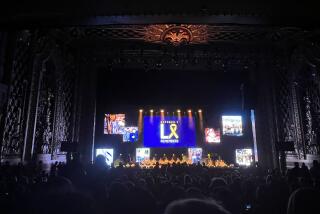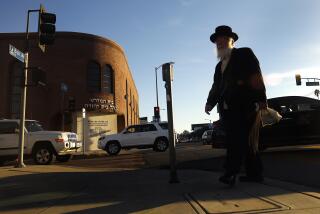‘Our worst nightmare’: Vandalism at Persian synagogue stuns congregation
The Torah scrolls lay strewn on the floor of Nessah Synagogue, some wrinkled and unraveled, others thrown on chairs alongside shredded prayer books. Piles of blue and white tallits and kippahs littered the floor, pulled from their cubbies by a vandal who had broken into the house of worship during Shabbat.
Around 7 a.m., an employee arrived to discover the chaos and called the police. By midday, word of the destruction had spread throughout the congregation.
“When my husband came home and told me what happened, I was shocked. The whole community was shocked,” said Simin Imanuel, a longtime congregant.
The vandalism at one of the country’s most prominent Iranian synagogues on Dec. 14 has stunned congregants who said they never thought the anti-Semitic graffiti and intolerance they saw happening at other temples and schools would reach their doorstep.
“Our worst nightmare basically came to light,” said Farzad Rabbany, who has been a member of the Beverly Hills synagogue for years. “This particular synagogue is very dear to the Jewish Iranians that fled the 1979 revolution in Iran, and this is what we call home. It is the largest Persian synagogue in the United States, and perhaps the world.”
The attack comes at a time when the community is especially alert to anti-Semitic violence. Earlier this month, two shooters killed three people at a Jewish grocery store, in addition to a police officer at a cemetery about a mile away. In April, a shooting at the Chabad of Poway synagogue in San Diego County came exactly six months after 11 worshipers were killed at the Tree of Life Synagogue in Pittsburgh.
Rabbany is grateful, he said, that the crime at his synagogue stopped at vandalism.
The synagogue was founded by Rabbi David Shofet, who immigrated to the United States in 1980 from Tehran in the aftermath of Iran’s Islamic Revolution. Shofet aimed to create a place in which Iranian Jews could pray together, maintain the traditions they followed back home and teach the next generation.
“This is the stuff that you don’t think is going to come and affect you personally, but it is unfortunately becoming a fact of life,” said Rabbany, who moved to Southern California in 1987 after fleeing Iran. “As Persian Jews, we have been through it all, and we know what anti-Semitism is. We know the danger of it.”
Hate crimes in Los Angeles County have reached their highest point in nearly a decade, according to an annual report by the L.A. County Commission on Human Relations. Although religious crimes overall declined slightly, anti-Jewish crimes rose 14% and constituted 83% of religion-motivated crimes.
But most anti-Semitic incidents in the U.S. do not happen at large events or through deadly violence.
Last year, the Anti-Defamation League reported that “4.2 million anti-Semitic tweets were shared or re-shared in English on Twitter” over a yearlong period ending in January 2018.
At a community town hall at the Beverly Hilton on Wednesday evening, Beverly Hills police announced that authorities had arrested a suspect in connection with the vandalism — news that was met with a standing ovation.
Anton Nathaniel Redding of Millersville, Pa., has been charged with vandalism of a religious property and commercial burglary, charges that include a penalty enhancement for a hate crime, police said.
Sitting in one of the back rows at the town hall, Beverly Hills Planning Commissioner Farshid Shooshani described the wreckage at his synagogue as “a shock to our system.”
“Our community has been here 40 years. This is the first time we’ve had such an incident,” said Shooshani. “It’s psychologically very devastating because being in Los Angeles, being in Beverly Hills, we are living in one of the safest cities in the area. Fortunately, the damage was not much, but I think people have realized that there’s danger everywhere.”
Shooshani’s wife and father-in-law were among the first members of the synagogue, he said.
“Our connections to the synagogue are very deep,” he said. “In a way, this is the center of the community ... our history began here. This is the mother synagogue and from this, people went to other synagogues in different places.”
Iranian Jews began immigrating to the United States in earnest amid the chaos of the 1979 revolution and the rise of Ayatollah Ruhollah Khomeini’s regime. Khomeini’s revolution drove about half of Iran’s 80,000 Jews into exile. Some moved to New York or Israel, but many of those immigrants have settled in or near Beverly Hills.
“Our city was one of the first places of refuge for a large portion of the Jewish Persian community,” Beverly Hills Mayor John Mirisch said. “This has been their home for more than 30 years.”
When Mirisch walked into Nessah Synagogue the morning of Dec. 14, he said, he cried at the sight of the damage.
“The images evoke something that is terrible because it goes to the heart of the disease that is Jew hatred, that has been around almost from time immemorial,” he said. “A painting thrown down, a clock broken and stopped, shattered glass — it brings back images of Kristallnacht.”
The synagogue has bound generations of families together. Rabbi Shofet’s father, Hakham Yedidia Shofet, was the chief rabbi of Tehran. Many congregants and their family members were married by the elder Shofet in Iran, while his son led their children’s wedding or bar mitzvah in Beverly Hills.
“Everyone in our community knows people who go there, whether it’s cousins or friends or fellow Iranian Jews,” Siamak Kordestani, assistant director of the American Jewish Committee’s Los Angeles office, said of Nessah. “When we are in a synagogue where Farsi is spoken or understood by so many people, you automatically feel like you are taken back to your country of origin.”
Kordestani, who had his bar mitzvah at Nessah, said that many fear anti-Semitic attacks or vandalism are becoming commonplace. Nessah’s main Torah scrolls were locked up and spared from the crime, he said, but the community is “definitely on edge.”
“I think there’s certainly a sense that our community has been targeted to a great extent throughout history, but also at the present moment — globally and around the country,” he said.
Thursday afternoon, hundreds of worshipers packed into Nessah’s pews for the conclusion of a rare public fast, praying to restore the Torah that was desecrated in the attack. The service began with cycles of whispered psalms, followed by the booming prayers of penitence that are recited on fast days and in the early mornings ahead of the autumn High Holidays.
When the Torah service finally arrived, the faithful rushed to the aisle as a group of longtime members removed a scroll from the ark and paraded it through the synagogue. Many wiped away tears as they strained to touch and kiss its silver cover.
Men embraced the sacred text. Women bowed before it and drew their cupped hands over their faces as though drawing the light from Sabbath candles, their normal veneration imbued with extra energy.
“Seeing it whole, now you feel your soul is whole,” congregant Desiree Kesherim said. “It’s like, you’re OK now.”
As community leaders opened the Torah scroll and held it aloft, hundreds of women broke into sudden, joyful ululations.
More to Read
Sign up for Essential California
The most important California stories and recommendations in your inbox every morning.
You may occasionally receive promotional content from the Los Angeles Times.












